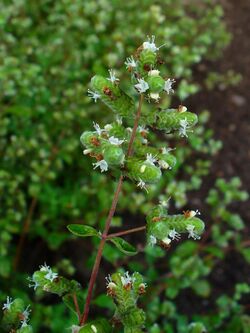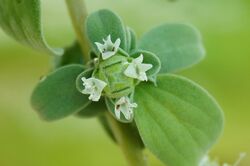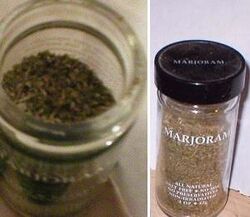Biology:Marjoram
| Marjoram | |
|---|---|

| |

| |
| Flowers | |
| Scientific classification | |
| Kingdom: | Plantae |
| Clade: | Tracheophytes |
| Clade: | Angiosperms |
| Clade: | Eudicots |
| Clade: | Asterids |
| Order: | Lamiales |
| Family: | Lamiaceae |
| Genus: | Origanum |
| Species: | O. majorana
|
| Binomial name | |
| Origanum majorana | |
| Synonyms[1] | |
| |
Marjoram (/ˈmɑːrdʒərəm/;[2] Origanum majorana) is a cold-sensitive perennial herb or undershrub with sweet pine and citrus flavours. In some Middle Eastern countries, marjoram is synonymous with oregano, and there the names sweet marjoram and knotted marjoram are used to distinguish it from other plants of the genus Origanum. It is also called pot marjoram,[3] although this name is also used for other cultivated species of Origanum.
History
Marjoram is indigenous to Cyprus, the Mediterranean, Turkey, Western Asia, the Arabian Peninsula, and the Levant, and was known to the ancient Ancient Greece and Romans as a symbol of happiness.[4] It may have spread to the British Isles during the Middle Ages.[5] Marjoram was not widely used in the United States until after World War II.[5]
The name marjoram (Old French: majorane; Template:Lang-la-x-medieval) does not directly derive from the Latin word maior (major).[6]
Marjoram is related to Samhain, the Celtic pagan holiday that would eventually become Halloween.[7] It has also been used in Sephardi Jewish tradition as a ritual medical practice.[8] Ancient Greece believed the plant was created by Aphrodite.[9] In one myth, the royal perfumer of Cyprus, Amaracus, was transformed into marjoram.[10] To the Romans the herb was known as the herb of happiness, and was believed to increase lifespan. Marjoram is mentioned in Pedanius Dioscorides’ De Materia Medica, and was used by Hippocrates as an antiseptic.[11]
Today, marjoram is used largely for consumption. Its popularity may be due to the rise of low-fat and low-salt diets, which require more seasoning.[citation needed]
Description
Leaves are smooth, simple, petiolated, ovate to oblong-ovate, 0.5–1.5 cm (0.2–0.6 inches) long, 0.2–0.8 cm (0.1–0.3 inches) wide, with obtuse apex, entire margin, symmetrical but tapering base, and reticulate venation. The texture of the leaf is extremely smooth due to the presence of numerous hairs.[12]
Cultivation
Considered a tender perennial (USDA Zones 7–9),[13] marjoram can sometimes prove hardy even in zone 5. Under proper conditions it spreads prolifically, and so is usually grown in pots to prevent it from taking over a garden.[14]
Marjoram is cultivated for its aromatic leaves, either green or dry, for culinary purposes; the tops are cut as the plants begin to flower and are dried slowly in the shade. It is often used in herb combinations such as herbes de Provence and za'atar. The flowering leaves and tops of marjoram are steam-distilled to produce an essential oil that is yellowish (darkening to brown as it ages). It has many chemical components, some of which are borneol, camphor, and pinene.
Related species
Oregano (Origanum vulgare), sometimes listed with marjoram as O. majorana, is also called wild marjoram. It is a perennial common in southern Europe and north to Sweden in dry copses and on hedge-banks, with many stout stems 30–80 centimetres (12–31 in) high, bearing short-stalked, somewhat ovate leaves and clusters of purple flowers. It has a stronger flavor than marjoram.
Pot marjoram or Cretan oregano (O. onites) has similar uses to marjoram.
Hardy marjoram or French/
O. × hybridum is known as showy marjoram or showy oregano.
Uses
Marjoram is used for seasoning soups, stews, salad dressings, sauces, and herbal teas.[16]
Marjoram has long been used as a medicinal herb. Marjoram or marjoram oil has been used to treat cancer, colds, coughs, cramps, depression, as a diuretic, ear infections, gastrointestinal problems, headaches, and paralysis, as well as arthritis, chest congestion, and muscle aches. It has also been used as an aphrodisiac, mouthwash, tea, and in poultices, tinctures, and infusions.[17][18][19][20][21] Though not all of its historic uses are scientifically backed, the plant has verifiable medical use. For example, it contains the phenol carvacrol, which is antibacterial, antifungal and antimicrobial.[22][23] Ethanol extract is cytotoxic against fibrosarcoma cell lines, ethyl acetate extract has antiproliferative properties against C6 and HeLa cells, as have hesperetin and hydroquinone, which can be isolated from marjoram extract.[24] Cardioprotective, hepatoprotective, antiulcerogenetic, anticholinesterase, anti-PCOS, and anti-inflammatory effects were also found in dried marjoram, marjoram tea, or in compounds extracted from marjoram.[24] Marjoram is generally not toxic, but should not be used by pregnant or lactating women.[24] However, it is always important to be cautious and consult a doctor when using medical herbs.[25]
See also
References
- ↑ 1.0 1.1 {{citation | mode = cs1 | title = Marjoram | work = Germplasm Resources Information Network (GRIN) | url = | publisher = [[Organization:Agricultural Research ServAgricultural Research Service (ARS), United States Department of Agriculture (USDA) | access-date = 2008-03-08 }}
- ↑ Company, Houghton Mifflin Harcourt Publishing. "The American Heritage Dictionary entry: marjoram". https://www.ahdictionary.com/word/search.html?q=marjoram.
- ↑ (xls) BSBI List 2007, Botanical Society of Britain and Ireland, https://bsbi.org/download/3542/, retrieved 2014-10-17
- ↑ "Marjoram is the happiness herb". 2 July 2013. https://www.santacruzsentinel.com/2013/07/02/in-the-bins-marjoram-is-the-happiness-herb/.
- ↑ 5.0 5.1 Sanderson, Helen; Renfrew, Jane M. (2005). Prance, Ghillean; Nesbitt, Mark. eds. The Cultural History of Plants. Routledge. p. 111. ISBN 0415927463.
- ↑ Harper, Douglas (2001). "marjoram (n.)". marjoram (n.). https://www.etymonline.com/word/marjoram. Retrieved 2023-02-07.[better source needed]
- ↑ Benveniste, Daniel (September 1990). "Tantric Art and the Primal Scene Ajit Mookerjee. Kali: The Feminine Force. Rochester, VT, Destiny Books (Inner Traditions International), 1988.". The San Francisco Jung Institute Library Journal 9 (4): 39–55. doi:10.1525/jung.1.1990.9.4.39. ISSN 0270-6210. http://dx.doi.org/10.1525/jung.1.1990.9.4.39.
- ↑ Jack., Lévy, Isaac (2002). Ritual medical lore of Sephardic women : sweetening the spirits, healing the sick. University of Illinois Press. ISBN 0-252-02697-7. OCLC 1170078028. http://worldcat.org/oclc/1170078028.
- ↑ Adams, Sue. Herb Folklore. https://adamsfarms.com/wp-content/uploads/2017/06/Herb-Folklore-by-Sue-Adams-for-Adams-Website.pdf.
- ↑ Caruso, Carlo (December 5, 2013). Adonis: The Myth of the Dying God in the Italian Renaissance. Bloomsbury. p. 116. ISBN 978-1-4725-3882-6. https://books.google.com/books?id=JagVAgAAQBAJ.
- ↑ "Assessment report on Origanum majorana L., herba". European Medicines Agency. 2016. https://www.ema.europa.eu/en/documents/herbal-report/final-assessment-report-origanum-majorana-l-herba_en.pdf.
- ↑ BP Pimple, AN Patel, PV Kadam, MJ Patil. Microscopic evaluation and physicochemical analysis of Origanum majorana Linn leaves . Asian Pacific Journal of Tropical Disease 2, S897-S903.
- ↑ "Learn 2 Grow: Origanum majorana". http://www.learn2grow.com/plants/origanum-majorana/.
- ↑ "Oregano and Marjoram" (in en-US). https://foodprint.org/real-food/oregano-and-marjoram/.
- ↑ "Origanum majoricum Cambess." (in en). https://www.gbif.org/species/3894423.
- ↑ "Marjoram, Herb". http://www.foodreference.com/html/tmarjoram.html.
- ↑ Johnson, Tim. 2002. Herbweb CD-ROM. (HSA Library)
- ↑ Krikorian, A. D. (December 1996). "Encyclopedia of Common Natural Ingredients Used in Food, Drugs, and Cosmetics. Albert Y. Leung, Steven Foster". The Quarterly Review of Biology 71 (4): 609. doi:10.1086/419639. ISSN 0033-5770. http://dx.doi.org/10.1086/419639.
- ↑ Gruenwald, Joerg, Thomas Brendler and Christof Jaenicke, eds. 2000. PDR for herbal medicines. Montvale, NJ: Medical Economics.
- ↑ Bown, Deni. 2001. The Herb Society of America new encyclopedia of herbs & their uses. New York: DK.
- ↑ Duke, James A. (2002). Handbook of medicinal herbs. CRC Press. ISBN 0-8493-1284-1. OCLC 899024950. http://worldcat.org/oclc/899024950.
- ↑ Gruenwald, Joerg, Thomas Brendler and Christof Jaenicke, eds. 2000. PDR for herbal medicines. Montvale, NJ: Medical Economics
- ↑ Tucker, Arthur O. and Thomas DeBaggio. 2000. The big book of herbs: a comprehensive illustrated reference to herbs of flavor and fragrance. Loveland, CO: Interweave Press.
- ↑ 24.0 24.1 24.2 Bina, Fatemeh; Rahimi, Roja (January 2017). "Sweet Marjoram: A Review of Ethnopharmacology, Phytochemistry, and Biological Activities". Journal of Evidence-Based Complementary & Alternative Medicine 22 (1): 175–185. doi:10.1177/2156587216650793. ISSN 2156-5899. PMID 27231340.
- ↑ Zehr, Vernon. "ConsumerMedSafety.org - Prevent Medication Errors - Consumer Med Safety" (in en-gb). https://consumermedsafety.org/herbals-vitamins-homeopathic-medicines/herbal-medicines-consult-with-your-doctor-before-use.
External links
| Wikimedia Commons has media related to Origanum majorana. |
- Origanum majorana List of Chemicals in Dr. Duke's Databases
- Origanum majorana in the Plants For A Future database
 "Marjoram". The American Cyclopædia. 1879.
"Marjoram". The American Cyclopædia. 1879.
Wikidata ☰ Q22694 entry
 |




